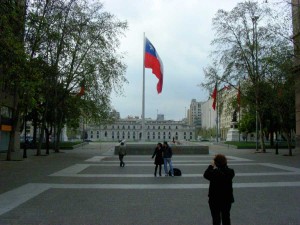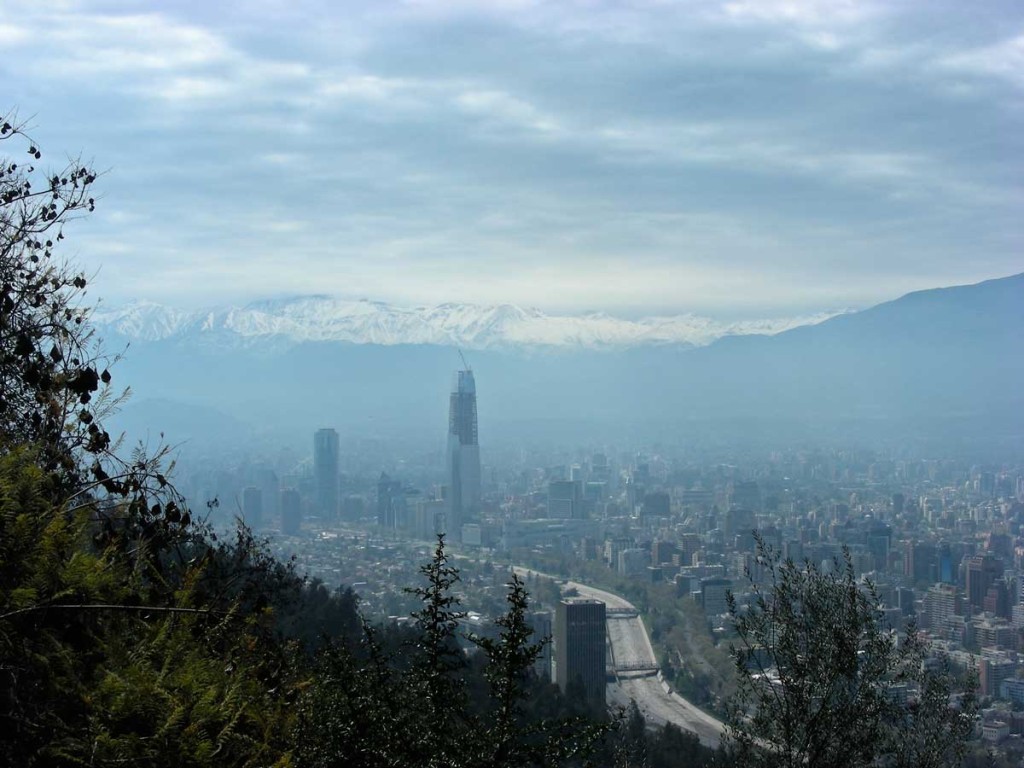It’s surprising to find that Santiago, capital of Chile (not de Cuba or de Compostela), can look a little forbidding at first sight, at least if you head straight for the centre. The presidential seat the Palacio de la Moneda, a neatly-proportioned neo-classical mansion typical of the last burst of building of the Spanish Empire – and forever associated for some of us with black-and-white film of it being bombed during Pinochet’s coup in 1973 – stands dwarfed by the giant square in front of it and the bland office blocks around it. In the middle of the square is an immense flag: the Mexican flag in the Zócalo in Mexico City is always lauded as the biggest flag in the world, but Chile’s competitor in the Plaza de la Moneda must run it a close second. The biggest surprise is the Paseo Bulnes, an again-giant avenue facing La Moneda from across the square, lined by uniform eight-storey blocks, most of them government buildings, in an up-and-down grey-box style that looks as if it could have been directly inspired by the blend of bleakness and giantism typical of the Soviet Union in its prime.

Any sense of elegant proportion or scale, or delicacy, charm and so on, seems thin on the ground. Beyond the outsize avenues, the most common buildings are bland, nondescript high-rise blocks from some time around the mid-20th century. There are surprisingly few Spanish colonial buildings, and none except La Moneda that especially catch the eye, and even the ornate French Beaux-Arts-style mansions and showcase public properties favoured by Chile’s elite in their boom-time circa 1900 are pushed a little into second place. There are charming small barrios dotted around the centre – such as Paris-Londres, two streets lined with eccentric neo-renaissance mansions, or Lastarria, with small squares and 19th-century houses that often now host cafés and artsy shops – but they too seem a bit corralled by the functionalist blocks looming up above them.

Santiago sits in a bowl of mountains at the foot of the Andes, which means, as happens with cities in mountain bowls, that the murk produced by all its cars, offices and whatever tends to get trapped and sit above it for days at a time, as you can appreciate if you climb up the main park of Cerro de San Cristóbal – a wonderful hilltop retreat within the city, with miles of woods and winding footpaths – and look down on the boxy blocks below. But, the mountains also give Santiago its most spectacular physical feature, the way you can walk down one of its big streets, look up and see a line of snow-topped peaks, apparently only just outside town.
The impression of exaggerated scale in some of Santiago’s avenues is particularly strong if you happen to arrive during Chile’s Fiestas Patrias, its independence day national holidays, which officially cover only the 18th and 19th September but tend to spread over the preceding days too (this year, since the 17th was a Monday, it was declared a holiday too). Chileans take their holidays seriously, and that means everybody. So, if you think, this is a holiday, I’ll go and visit a museum – forget it. National art collections? Closed. The house of Pablo Neruda? Closed. The museum staff have a holiday same as everybody else. Even many restaurants are closed. The only thing not closed at all, thankfully, is public transport.
So Santiago effectively shuts down for several days, like a whole string of lazy Sundays. What it looks like on a normal day, I realise I probably have no idea. For the fiestas the crowds all migrate to the Parque O’Higgins, where long lines of stalls and big tents called fondas offer all sorts of goodies like Chilean empanadas and mean-looking fruit cocktails called terremotos to go with the music, dancing and a few doses of folklore. The rest of the city is strangely empty. And when people and cars can only be counted in ones and twos, the scale of its official streetscapes and their martial statues of Chilean heroes seems even larger.
BUT, despite all this architectural severity (or even clumsiness) Santiago is actually not forbidding or severe at all. Any risk of hard edges is taken off by the amiability of its people. This is not just a polite cliché, but something tangible. Obviously, anyone who ventures into generalisations about the demeanour of a whole city on the basis of a rapid impression is taking a risk of missing reality by a mile and making a fool of themselves, but, I’ve been to few places where people are so keen to answer questions from disoriented visitors, and do it so charmingly, and without any kind of smart-alicky I’ll-put-you-right undertone. People smile at you, not stupidly but welcomingly, in a way you just wouldn’t expect in many cities. You start to really look forward to asking for directions, just to bask in the warmth of the reaction. It’s just odd that much of the surroundings seem to have missed out on the same charm.
Recent Comments